One of the biggest excuses people give for not investing is that they don’t have enough money. But with platforms like M1 Finance, it’s no longer a valid reason to avoid getting started. M1 Finance is a robo-advisor platform that lets you open an account with no money upfront and begin investing with just $100 in your account.
Unlike most robot platforms, however, M1 Finance allows you to select the investments you’ll hold in your account, offering a mix of self-directed and automated investing.
In this M1 Finance review, I’ll cover all the basics: key features, how to sign up, pros and cons, etc. I’ll even share some M1 Finance Alternatives to help you decide if M1 Finance is the right platform to start investing in.

- * Account Minimum $100
- * Build custom portfolios (or)
- * Choose expert portfolios
- * Stocks, ETFs, REITs
Table of Contents
- Introducing M1 Finance
- M1 Finance Accounts: M1 Basic vs. M1 Plus
- The M1 Finance Robo Advisor: Key Features
- M1 Finance Tax Considerations
- How Does M1 Finance Make Money?
- How to Get Started With M1 Finance
- M1 Finance Step-By-Step Tutorial
- M1 Finance Pros and Cons
- M1 Finance Alternatives
- Is M1 Finance Safe?
- Final Thoughts on M1 Finance
Introducing M1 Finance
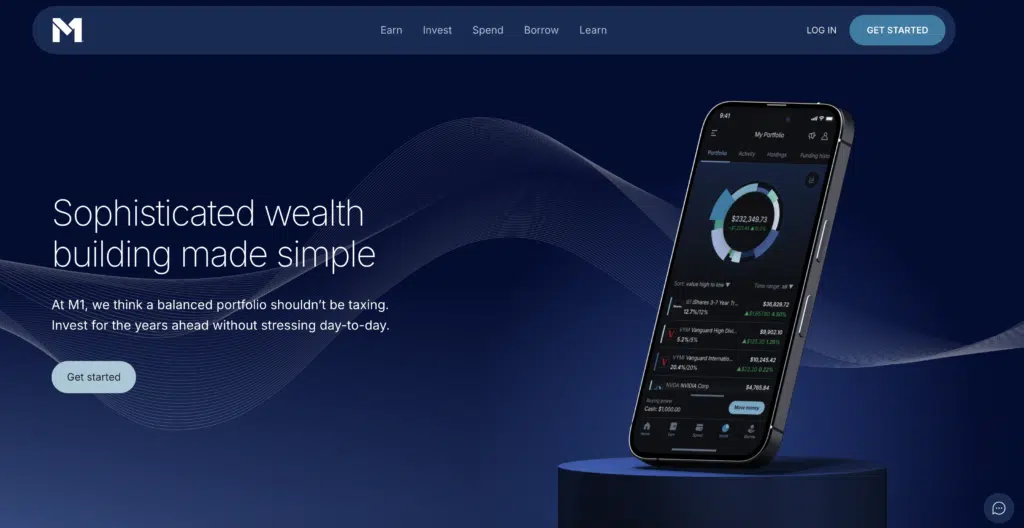
Founded in 2015 and based in Dallas, Texas, M1 Finance is a robo-advisor for investors who like the robo-advisor concept but want more direct control over their investments.
M1 Finance gives you both. You can choose the investments in your portfolio or select from a range of expert portfolios that are pre-built and based on predetermined investment templates.
M1 Finance portfolios are known as Pies. Each Pie can consist of individual stocks, ETFs, and Crypto. The investments inside the Pies are referred to as Slices.
Your investment account can be comprised of one or more Pies. As mentioned, you can build your Pies (portfolios) from the ground up or choose from Expert Pies already built for you.
The robo-advisor side of M1 Finance is based on Modern Portfolio Theory (MPT), which is true of all robo-advisors, meaning once you select a Pie, it’s fully managed by M1 Finance. It will be rebalanced regularly to maintain its target asset allocation.
M1 Finance Accounts: M1 Basic vs. M1 Plus
M1 Finance offers two accounts, M1 Basic and M1 Plus. Here’s a closer look at the essential features of each account:
M1 Basic
An M1 Basic membership is free and provides access to several M1 products and services, including M1 Invest, Savings, and Borrow accounts.
What you get:
- No annual fees
- No minimum balance
- Commission-free investing
- Borrow at 6.25% APY (Margin Loan)
- M1 high yield savings account (4.00% APY)
- 0% cash back
- FDIC-insured up to $250,000
- 1 ATM fee reimbursement per month
- 0.8%-1% international fees
- Early direct deposit
m your investment account to pay down the loan. Also, the interest rate is variable and can fluctuate.
The M1 Finance Robo Advisor: Key Features
M1 Finance departs from traditional robo-advisors in several important respects:
- No risk tolerance questionnaire is required.
- Option to select your investments.
- Not limited to ETFs (individual stocks are available)
- Change your investment choices at any time.
- Invest in multiple portfolios in a single account
M1 “Pie” Investing
The M1 Finance methodology works based on what they refer to as “pies,” with different types available. You can create your own or choose from several Expert Pies, which are pre-built.
M1 Finance offers more than 60 Expert Pies. Each is typically made up of between seven and nine ETFs. They’re usually Vanguard funds, with some of the industry’s lowest expense ratios. You can also create custom pies built with ETFs and stocks of your choosing but within the framework of investment templates.
Each pie can contain as many as 100 “slices,” each being either an ETF or a stock. A slice can also be an entire pie – that’s how much flexibility the platform provides.
There are, however, a couple of limitations:
- You cannot invest in mutual funds.
- Stocks must be selected from the New York Stock Exchange, NASDAQ, or the BATS system.
The limited selection is how M1 Finance can offer no-fee investing. They specialize in stocks and ETFs only. If you want to hold other investments, like penny stocks, options, mutual funds, or cryptocurrencies, you’ll have to go with another investment platform.
As you add funds to a pie, M1 Finance will go into robo-advisor mode and invest the funds within the scope of the desired target allocations for that portfolio.
Portfolio Rebalancing
M1 Finance provides rebalancing, but they work differently from other robo-advisors. Generally speaking, rebalancing is not automatic – you have to initiate it. And when it happens, it may require the sale of investments that may generate taxable transactions.
Instead, M1 Finance employs something known as Dynamic Rebalancing, where new cash into your account is used to help rebalance your portfolio. The process has two advantages:
1. It enables you to buy a larger number of the lower-priced investments in your pies; and,
2. It minimizes the need to generate taxable sales by reducing positions where you’re overweight.
This isn’t the typical rebalancing methodology used by robo-advisors, but it has some definite advantages.
Dividend Reinvestment
M1 Finance allows for flexible dividend reinvesting. Once dividends are paid into your cash account, you’ll set a cash control threshold (the dollar amount of your reinvestment.) You can choose any amount for the threshold – or even choose not to reinvest dividends.
If you don’t decide, the threshold will automatically be $10. Each time dividend contributions in your cash account reach $10, the funds will be transferred to your pies and distributed according to your target allocations.
M1 Finance’s investment “Pies” combine elements of a robo advisor with self-directed investing.
More Info on M1 Finance Pies
When you decide on a Pie – expert or custom – you’ll be able to set percentage allocations for the pie. Those allocations will be maintained as you add or withdraw funds from your account.
M1 Finance Pie Example
M1 Finance uses an example of a portfolio invested in the so-called FAANG stocks (Facebook, Apple, Amazon, Netflix, and Google).
If you choose this Pie, you can go with an even allocation between each of the five stocks, at 20% each. But you can also change the allocation within the pie.
For example:
Market Sector Pies
You can also create pies based on market sectors. This can include socially responsible investing, healthcare, utilities, and even foreign countries. You can create an unlimited number of pies within your account.
When you first open your account, you can establish investment allocations.
For example, when you contribute $1,000, you can set how much will go into investments and how much will be held in cash. This will enable you to minimize cash drag (uninvested funds that earn no investment income).
One of the features with M1 Finance I like is that you can set the allocations in your pies and make changes at any time. That’s another feature that’s not offered by most other robo-advisors. It allows you to customize your pies anytime your investment objectives or risk tolerance changes.
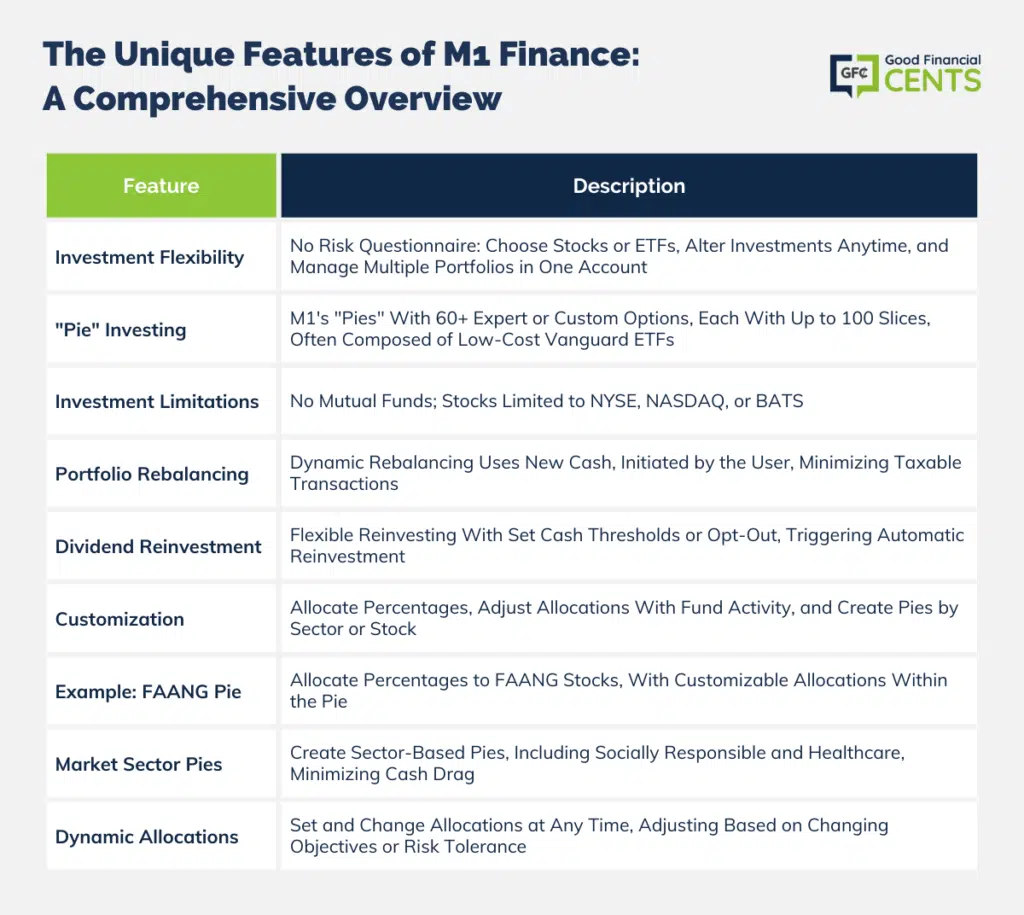
M1 Finance Tax Considerations
One other area where M1 Finance departs from many robo-advisors is that they don’t offer tax-loss harvesting. However, they use a tax lots strategy when securities are sold. It works to reduce the capital gains taxes you’ll pay.
M1 Finance uses an algorithm to determine which securities are sold when you withdraw funds from your account.
The priority works as follows:
1. Losses that offset future gains.
2. Lots that result in long-term capital gains (to get lower tax rates on long-term capital gains).
3. Lots that result in short-term capital gains (done as a last resort since these gains are taxable at ordinary tax rates).
Get Started with M1 Finance
How Does M1 Finance Make Money?
This is a question I always ask about any free service – After all if a service is free, you have to wonder how long it’ll hang around.
M1 Finance makes money by lending out securities for short sales (which you can’t do on this platform), and from margin loans issued to M1 Finance investors. The interest earned generates revenue for M1 Finance.
This is a common practice in the investment industry and a significant reason why M1 Finance doesn’t charge fees to its investors.
How to Get Started With M1 Finance
If you want to open an account with M1 Finance, you’ll need to meet the following qualifications:
- US citizen or a permanent US resident.
- Be at least 18 years old.
- Have a current US mailing address.
If you meet the qualifications, M1 Finance has a straightforward and quick setup process:
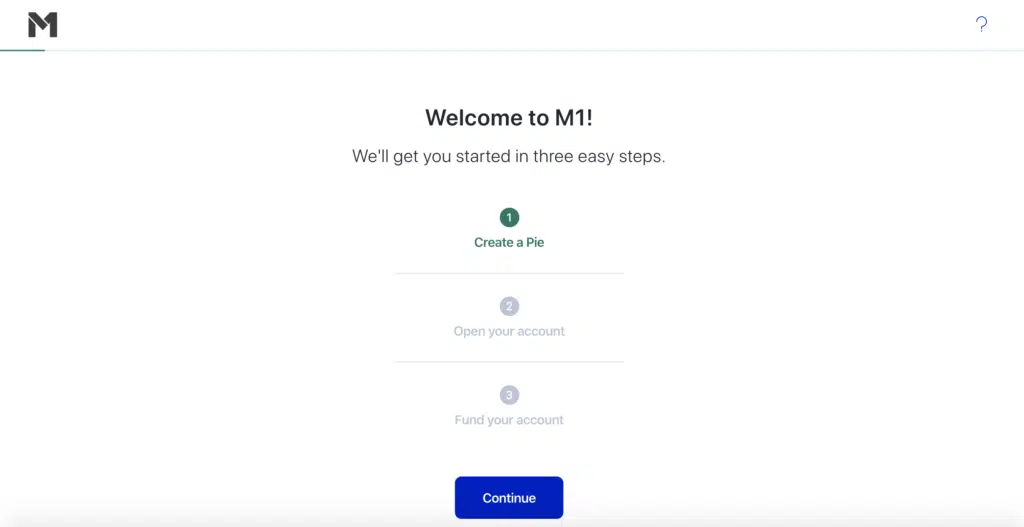
1. Build a Portfolio
Choose your risk level, then select from prebuilt pies or create your own. If you create your own, you’ll need to choose the individual investments: stocks or ETFs. That will start by selecting your allocations.
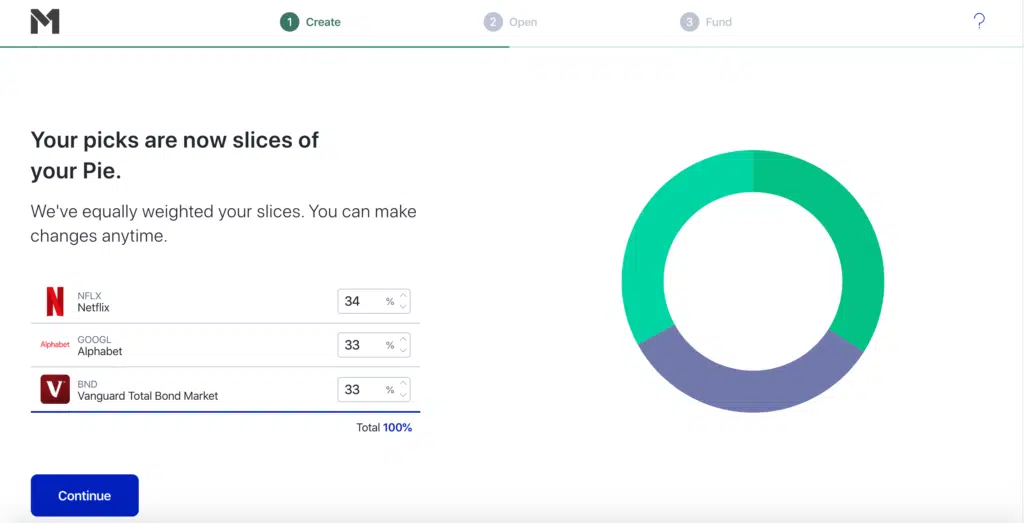
Once you choose your portfolio allocations, you can select the funds and stocks you want in your Pies. The platform provides descriptions of each fund and stock available, complete with plenty of information and multi-year performance records.
2. Open Your Brokerage Account
Next, choose an individual or joint taxable account, a trust, or a retirement account. You’ll need to provide your personal information, including financial information, such as your income, net worth, liquid net worth, etc. M1 Finance will also ask questions to help determine your investor profile. There are seven different investor profiles, ranging from ultra-conservative to ultra-aggressive. Choose the one that best fits your investor profile.
3. Fund Your Portfolio
Select the bank you’ll link to your M1 Finance account. There are hundreds of banks in the database; you can add a different bank if it’s not there. You’ll need to log into your bank account from the M1 platform, and then link it to your account. When I opened my account, the funds took two business days to move over. You can set up either a one-time transfer or recurring transfers.
Get Started with M1 Finance
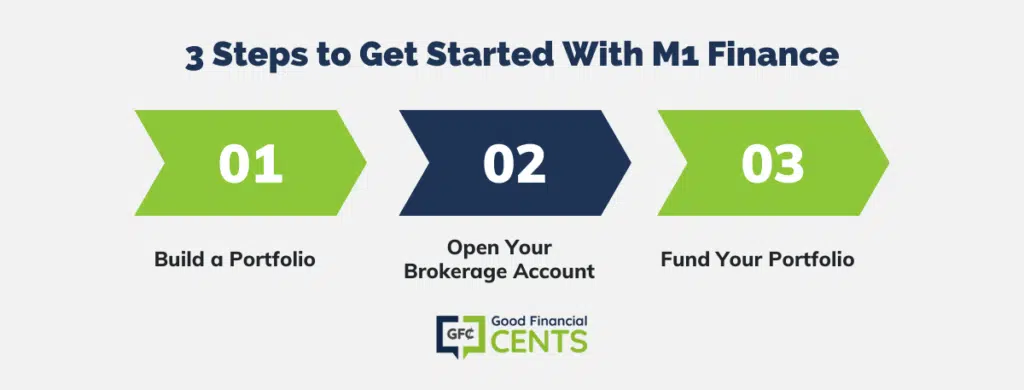
M1 Finance Step-By-Step Tutorial
If you feel you’re ready to sign up for M1 Finance but are worried about setting up your investment pies, I’ve got your back!
I recorded this step-by-step tutorial that walks you through the entire process. You’ll learn how to create your custom investment pie, choose from their expert pies, rebalance your investments, and everything else you need to succeed. You can watch the video here:
M1 Finance Pros and Cons
There’s a lot to like about M1 Finance. Unlike most robo-advisors, which only offer ETF portfolios, you can build M1 pies with individual stocks and ETFs. No trading fees and the low minimum investment amount of $100 are also great features.
What are the cons of using M1 Finance? Some investors may not like that you can’t hold mutual funds and that they don’t offer tax-loss harvesting. On its website, M1 Finance explains its approach to creating tax efficiencies for investors.
Here’s my full list of pros and cons:
M1 Finance Alternatives
There are several other robo-advisors to consider in addition to M1 Finance. While they share many similarities, each one has its unique features. If you’re unsure if M1 Finance is the right investment platform for you, I recommend that you check and compare to the following M1 Finance alternatives:
Betterment
Betterment is a pure robo-advisor service offering a wide range of expert-built ETF portfolios, including Socially Responsible Investing portfolios (SRI). While they lack the customization of M1 Finance Pies, you can start investing with as little as $10 (vs. $100 for M1 Finance), and their $4 monthly fee is lower than what you pay for M1 Plus.
Like M1 Plus, Betterment offers a high-yield savings account (Betterment Cash Reserve) that currently pays a 4.00% APY. Once your holdings exceed $20,000, your fee will transition from $4/month to a 0.25% annual fee on your Betterment Invest portfolio balance. Unlike M1 Finance, Betterment offers tax loss harvesting. Learn more in our full Betterment Investing review.
Wealthfront
Wealthfront is a robo advisor platform offering automated investing and a high-yield savings account currently paying a 3.80% APY. Like Betterment, Wealthfront offers SRI portfolios. Wealthfront’s fees are higher than M1 Finance, especially for larger accounts. They charge a 0.25% annual portfolio management fee. That’s $250/year on a $100,000 portfolio. Wealthfront does offer tax loss harvesting. Learn more in our Wealthfront review.
Get Started with Wealthfront
Personal Capital
Personal Capital offers a robo advisor service, but it’s more costly and comes with a much higher barrier to entry than either M1 Finance or the other alternatives listed above. PC’s minimum investment amount is $100,000, and the annual management fee is 0.89% for portfolios up to $1 million.
If you have a larger amount to invest and can stomach the higher fee, Personal Capital provides access to a human advisor, excellent retirement planning, and other investment tools. Check out our Personal Capital review for more information.
Get Started with Personal Capital
Is M1 Finance Safe?
The short answer is “Yes”; M1 Finance is safe for investors. They employ similar levels of encryption that banks use for their online banking platforms and offer two-factor authentication (2FA) on all accounts. M1 Finance investment accounts are insured for up to $500,000 by the Securities Investor Protection Corporation (SIPC).

- * Account Minimum $100
- * Build custom portfolios (or)
- * Choose expert portfolios
- * Stocks, ETFs, REITs
Final Thoughts on M1 Finance
By giving you so much control over the investments in your account, M1 Finance is unique among robo-advisors. No fee investing and a low minimum investment of $100 make it an ideal platform for beginners and small investors.
Because M1 Finance allows you to make changes to your portfolio, newer investors could start by investing in Expert Pies and begin building custom Pies as they gain confidence.
That said, M1 Finance is not ideal for active traders, and it lacks the market research tools that self-directed investors are looking for in an online brokerage.
How We Review Brokers and Investment Companies:
Good Financial Cents conducts a thorough review of U.S. brokers, focusing on assets under management and notable industry trends. Our primary objective is to offer a balanced and informative assessment, assisting individuals in making informed decisions about their investment choices. We believe in maintaining a transparent editorial process.
To achieve this, we gather data from providers through detailed questionnaires and take the time to observe provider demonstrations. This hands-on approach, combined with our independent research, forms the basis of our evaluation process. After considering various factors, we assign a star rating, ranging from one to five, to each broker.
For a deeper understanding of the criteria we use to rate brokers and our evaluation approach, please refer to our editorial guidelines and full disclaimer.
M1 Finance Review

Product Name: M1 Finance
Product Description: M1 Finance is a low-cost robo-advisor platform that lets investors create custom stock and ETF portfolios or choose from a range of pre-designed portfolios.
Summary of M1 Finance
M1 Finance is a robo-advisor platform that lets investors create custom portfolios or select from a range of pre-built portfolios.
-
Cost and Fees
-
Customer Service
-
User Experience
-
Product Offerings
Overall
Pros
- There are no fees to use M1 Finance. They don’t even charge trading fees.
- You can choose the portfolios (pies) you invest in.
- Pies can hold ETFs and individual stocks, unlike the way most robo-advisors work, investing in ETFs only.
- No initial deposit is required to open an account, though you do need at least $100 to begin investing or $500 for an IRA account.
- Because M1 Finance allows fractional shares, you can build pies with small amounts of money. This makes it easier to diversify a small pie with different stocks.
- M1 Borrow enables you to borrow against your account at interest rates well below market rates.
- There are no fees to use M1 Finance. They don’t even charge trading fees.
- You can choose the portfolios (pies) you invest in.
- Pies can hold ETFs and individual stocks, unlike the way most robo-advisors work, investing in ETFs only.
- No initial deposit is required to open an account, though you do need at least $100 to begin investing or $500 for an IRA account.
- Because M1 Finance allows fractional shares, you can build pies with small amounts of money. This makes it easier to diversify a small pie with different stocks.
- M1 Borrow enables you to borrow against your account at interest rates well below market rates.
Cons
- Mutual funds are not available for constructing pies.
- No tax-loss harvesting is offered, potentially lowering your capital gains tax liability. This is fast becoming a standard feature with robo-advisors.
- Since you can create an unlimited number of pies, you run the risk of over-diversifying your account.
- You can include stocks in your pie investments, but you can’t use M1 Finance to trade securities. It is, after all, a robo-advisor.








Good review. What I like most about this is the ability to borrow against your investments at what seems like a reasonable interest rate. Good for entrepreneurs and small business owners to use as a last resort line of credit for emergencies or when cash flow is tight.